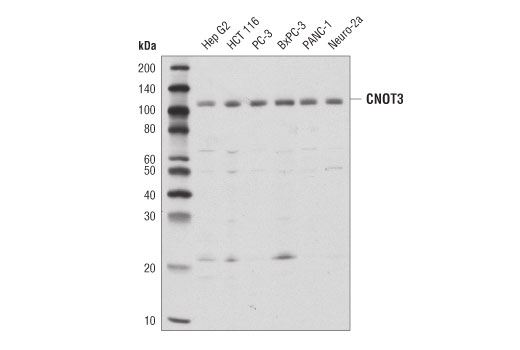 全部商品分类
全部商品分类
产品介绍
产品介绍
产品信息
荧光素标记
来源纯化
Monoclonal antibody is produced by immunizing animals with a synthetic peptide corresponding to residues near the carboxy terminus of human CNOT3 protein.

宿主
Rabbit

商品描述
Product Usage Information
| Application | Dilution |
|---|---|
| Western Blotting | 1:1000 |
| Immunoprecipitation | 1:50 |

同种型
Rabbit IgG

分子量
105

应用
目标/特异性
Specificity/Sensitivity
CNOT3 (D4K4N) Rabbit mAb recognizes endogenous levels of total CNOT3 protein.
Species Reactivity:
Human, Mouse, Rat, Monkey

敏感性
Endogenous

背景
背景
The evolutionarily conserved CCR4-NOT (CNOT) complex regulates mRNA metabolism in eukaryotic cells (1). This regulation occurs at different levels of mRNA synthesis and degradation, including transcription initiation, elongation, deadenylation, and degradation (1). Multiple components, including CNOT1, CNOT2, CNOT3, CNOT4, CNOT6, CNOT6L, CNOT7, CNOT8, CNOT9, and CNOT10 have been identified in this complex (2). In addition, subunit composition of this complex has been shown to vary among different tissues (3).Research studies indicate that CNOT3 (along with CNOT1 and CNOT2) represses early developmental transcription factor expression, helping to maintain embryonic stem (ES) cell identity in mice and humans (4). Additional studies suggest that CNOT3 plays a role in mitotic progression as it destabilizes mitotic spindle assembly protein MAD1 mRNA (5). Finally, CNOT3 appears to act as a modifier gene affecting the penetrance of mutations causing autosomal dominant retinitis pigmentosa (6) and as a tumor suppressor associated with cases of adult T-cell acute lymphoblastic leukemia (7).
1.Denis, C.L. and Chen, J. (2003) Prog Nucleic Acid Res Mol Biol 73, 221-50.
2.Lau, N.C. et al. (2009) Biochem J 422, 443-53.
3.Chen, C. et al. (2011) Biochem Biophys Res Commun 411, 360-4.
4.Zheng, X. et al. (2012) Stem Cells 30, 910-22.
5.Takahashi, A. et al. (2012) Biochem Biophys Res Commun 419, 268-73.
6.Venturini, G. et al. (2012) PLoS Genet 8, e1003040.
7.De Keersmaecker, K. et al. (2013) Nat Genet 45, 186-90.

研究领域
RNA 调节与翻译调控
翻译后修饰
unmodified

制备和贮存
保存方式
Supplied in 10 mM sodium HEPES (pH 7.5), 150 mM NaCl, 100 µg/ml BSA, 50% glycerol and less than 0.02% sodium azide. Store at –20°C. Do not aliquot the antibody.
数据库链接
Entrez-Gene ID
4849

UniProt ID
O75175

参考图片
Western blot analysis of extracts from various cell lines using CNOT3 (D4K4N) Rabbit mAb.
声明 :本官网所有报价均为常温或者蓝冰运输价格,如有产品需要干冰运输,需另外加收干冰运输费。








 用小程序,查商品更便捷
用小程序,查商品更便捷




